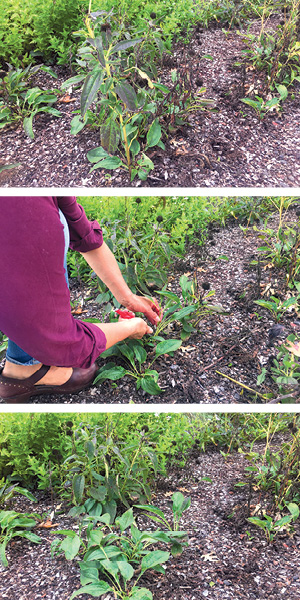Taming the Wild

Director of Horticulture Andrea DeLong-Amaya demonstrates how to prune — fearlessly. PHOTOS Joanna Wojtkowiak
Are you terrified of trimming Turk’s cap? Shaky about shearing switchgrass? Worried that the Garden Police will slap you a ticket for deadheading your purple coneflowers before the goldfinches finish their seedy feast? We hear you. That’s why we’ve gathered some tips to hoist your horticultural confidence when tending herbaceous ornamentals.
Every garden needs direction to read as a “garden” and not some wayward patch of weeds. Aside from removing damaged or diseased plants (or parts of plants) to sustain a healthy garden, it may be comforting to know there is no one right way to manage plant growth. Untrimmed wild plants survive just fine without a gardener’s hand, thank you, but may not support a garden aesthetic. What looks good to you and how much patience you have are important factors to consider before brandishing your clippers.
“Deadheading” is a good place to start. This describes the removal of spent flowers and stems before seeds form. It cleans things up and encourages more blossoms to please your eyes and nourish pollinators. But you may wish to refrain with purple coneflower (Echinacea purpurea), zexmenia (Wedelia acapulcensis var. hispida) and other producers until wildlife polish off the seed — or until seeds meet soil if you’re aiming to bolster the next generation.
Gardeners often opt to let giant coneflower and the like stand for their striking stalks even after blossoms peak. Gayfeathers (Liatris spp.), goldenrods (Solidago spp.) and purple coneflower each lend their distinct character and are excellent candidates for winter interest. When stems fall akimbo or otherwise become pitiful, deploy the shears. This task typically lands in late winter for summer and fall bloomers, and during summer for spring performers such as winecup (Callirhoe involucrata) or cedar sage (Salvia roemeriana).
Preferences drive shaping. Sometimes intermingling plants demonstrate a clever design or happy accident, but most often trimming plants away from one another avoids unintentional scruffiness. Gardeners control and redirect growth by understanding “apical dominance,” a phenomenon in which hormones in the terminal bud (or apex) of a branch inhibit side-branching. Pruning off leading tips removes these hormones and encourages lateral growth, creating a bushier overall form. Shearing and tipping represent the most common techniques based on this tendency. Light, frequent attention results in tighter, denser foliage and a more formal style. If you prefer a relaxed feel, shear less often. Periodic trims help plants from looking like a second-grader after a play session of “hair salon.”
A couple of situations are not solved by cutting: If mature plants wax too large, replace them with more appropriate smaller species. And shearing, unfortunately, cannot correct habitual legginess caused when plants stretch towards more sunlight. Find alternatives better suited for shade. However, if conditions change for the better, say, a fallen elm lets more light reach a lantana, rehabilitate the lantana by lopping it to nubs and allowing it to resprout. It sounds extreme, but it works!
After the sharp tongue of a hard freeze licks your deciduous perennials, such as river fern (Thelypteris kunthii) and tropical sage (Salvia coccinea), trim them to the ground. For Turk’s cap (Malvaviscus arboreus var. drummondii), shrubby boneset (Ageratina havanensis), Texas lantana (Lantana urticoides) and other woody or semi-woody plants, leave 2 to 6 inches of stem. Or wait until leaves emerge in spring, then nip off dead tips, which will result in larger plants. Mealy blue sage (Salvia farinacea), giant coneflower (Rudbeckia maxima) and Engelmann’s daisy (Engelmannia peristenia) push out evergreen winter rosettes that are best left intact, but rough-looking aerial parts can feed the compost pile.
Cherry or autumn sage (Salvia greggii) requires more detailed upkeep. Sometime around Valentine’s Day, clip out the thickest woody stems, then shape the remaining greenery. After each bloom cycle, lightly shear finished flower stems to the foliage and continue to shape them periodically throughout the growing season. This keeps plants fresh and maximizes blooming.
What about ornamental grasses? Manage them according to two categories. Little bluestem (Schizachyrium scoparium), switchgrass (Panicum virgatum), inland sea oats (Chasmanthium latifolium) and most other clump grasses die completely to the ground in winter. Leave them standing as long as they appeal. Then, before fresh spring blades emerge, clip last year’s tired growth to a few inches above the ground.
Muhlys, including Lindheimer’s muhly (Muhlenbergia lindheimeri) and Gulf muhly (M. capillaris), comprise the second group. Since they maintain some evergreen foliage during winter, thus continuing photosynthesis, a hard military cut may overly stress plants (and the ghostly silhouette looks weird). Yet old, decadent grasses are weakened by years of accumulated dead material. Ideally, burn them! Built for fire, they respond quickly and vigorously to such treatment. The next best option — assuming you do not have staff professionally trained in fire management — involves breaking off brittle stems low in the plant with a gloved hand, followed by combing loose foliage with a leaf rake, taking care to groom “under the skirt.”
Native plants often endure a reputation of looking unkempt. We admire their need for fewer resources to thrive, but they still need care to look good. This, friends, is gardening.

